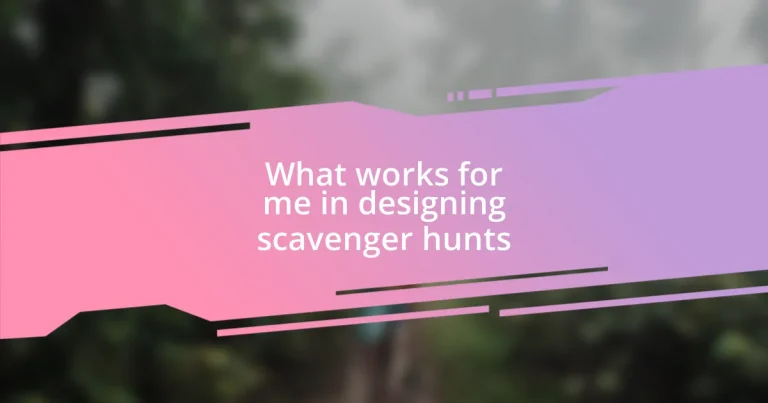Key takeaways:
- Scavenger hunts foster teamwork, creativity, and engagement across all ages, enhancing social interactions and connections among participants.
- Effectively crafted clues, combining riddles, personal memories, and imaginative descriptions, can elevate the experience by encouraging critical thinking and mindfulness.
- Logistical planning, including route mapping and having backup plans, is essential for a smooth scavenger hunt experience, ensuring participants remain engaged and enjoy memorable moments.
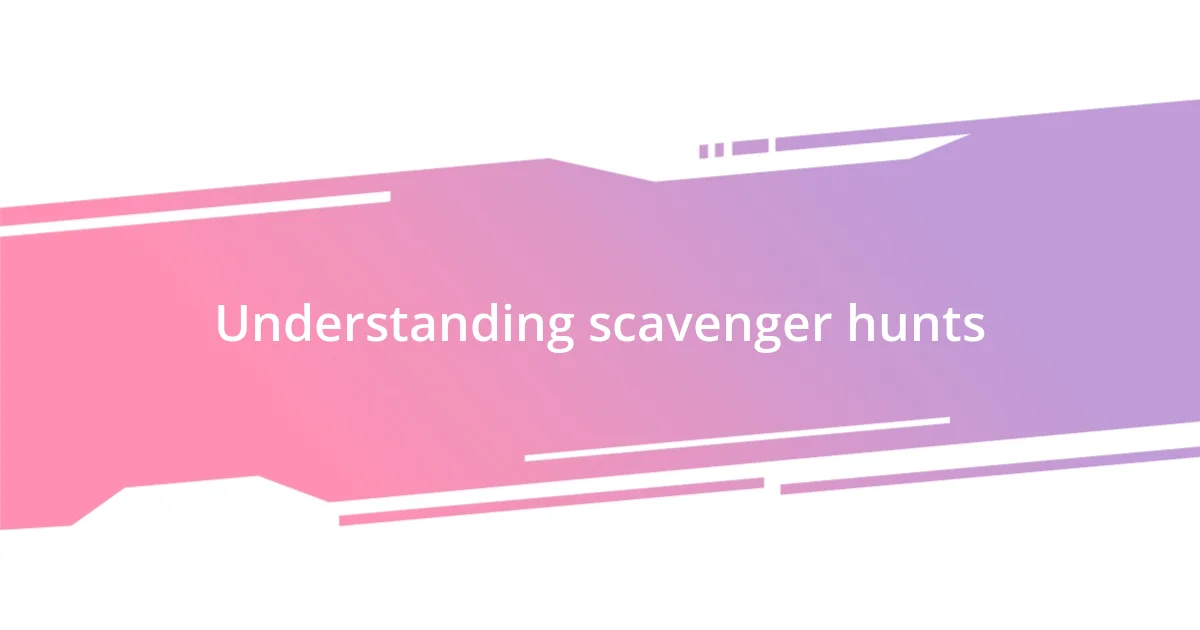
Understanding scavenger hunts
Scavenger hunts are more than just a fun way to explore; they’re an amazing blend of problem-solving and creativity. I remember organizing one for my niece’s birthday that turned into a magical adventure. As the kids raced through the park, their laughter echoed, and their eyes lit up with excitement every time they found a hidden clue. Isn’t it fascinating how a simple list can spark such joy?
At their core, scavenger hunts encourage teamwork and strategic thinking. I often see participants banding together, sharing ideas, and navigating challenges. It’s a beautiful sight to watch different personalities contribute their strengths and witness friendships blossom in the process. Have you ever been part of a team where everyone brought something unique to the table? Those moments feel electric, don’t they?
Understanding scavenger hunts means recognizing their potential to engage all ages. Whether you’re planning a local adventure with friends or a grand event for an organization, the thrill of discovery is universal. I’ve seen elderly participants immersed in nostalgia as they navigate familiar places, proving that the joy of exploration knows no age limit. Isn’t that what makes scavenger hunts so special?
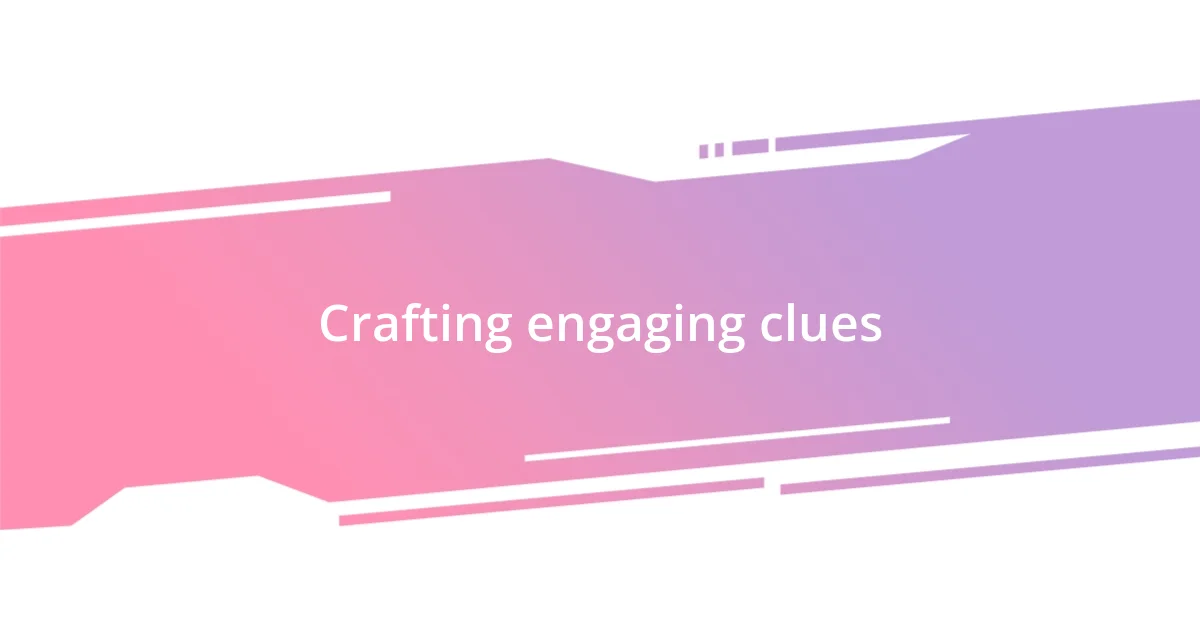
Crafting engaging clues
Crafting engaging clues is an art form that can elevate the entire scavenger hunt experience. I like to think of clues as little puzzles that not only lead participants to the next location but also enhance their journey with creativity. For example, I once integrated a riddle that required the team to think critically about their surroundings, which not only made the hunt more immersive but also kept everyone actively engaged. Have you ever noticed how a clever clue can ignite a spark of curiosity?
The structure of your clues plays a crucial role in their effectiveness. I often mix straightforward hints with more thought-provoking challenges. In one scavenger hunt, I crafted clues that involved personal memories tied to specific locations. This not only helped participants connect with the hunt on a personal level but also evoked shared laughter and stories among them, enriching the overall experience. Did you catch how a single clue can weave in personal narratives?
Ultimately, the best clues inspire imagination. When I designed a nature scavenger hunt, I encouraged participants to think about the sights and sounds around them. One clue read, “Find where the leaves dance in the wind,” prompting the team to pause, look up, and appreciate the beauty of their surroundings. This type of engagement not only leads to the next clue but also fosters a deeper appreciation for the environment. Isn’t it rewarding when a scavenger hunt leads to both fun and reflection?
| Clue Type | Engagement Level |
|---|---|
| Riddles | High – Promotes critical thinking |
| Personalized Memory Hints | Very High – Evokes nostalgia and shared laughter |
| Imaginative Descriptions | High – Encourages mindfulness and appreciation |
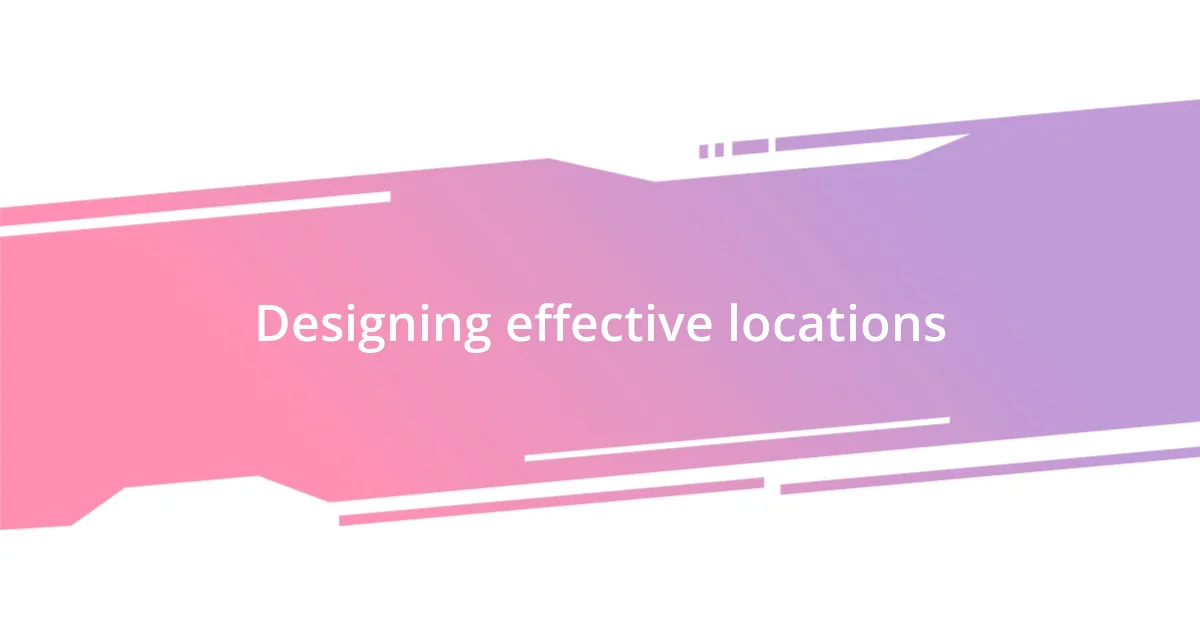
Designing effective locations
Designing effective locations is all about finding the perfect balance between accessibility and challenge. While I love exploring hidden gems, I’ve learned that the spots I choose need to be relatable yet intriguing. For instance, I remember one hunt where we utilized a local library. The cozy nooks not only stirred nostalgia for many participants who had spent their childhood hours there, but also sparked curiosity with their quiet corners. It’s amazing how even familiar places can feel brand new through the lens of a scavenger hunt.
To ensure a seamless experience, I consider several key factors when selecting locations:
- Accessibility: Ensure participants can easily reach each spot, allowing for smooth transitions.
- Variety: Include a mix of outdoor and indoor locations to keep the excitement alive.
- Significance: Choose places with a story or emotional connection, which can enhance engagement.
- Safety: Make sure areas are safe and comfortable for all participants, avoiding anything that could detract from the fun.
- Surprise Elements: Incorporate unexpected features, like a hidden garden or an art installation, to keep the adventure lively.
This approach not only adds depth to the hunt but also creates meaningful connections among participants as they explore together. Have you ever felt that thrill of discovery in a place you thought you knew? It’s those moments that make scavenger hunts truly unforgettable!
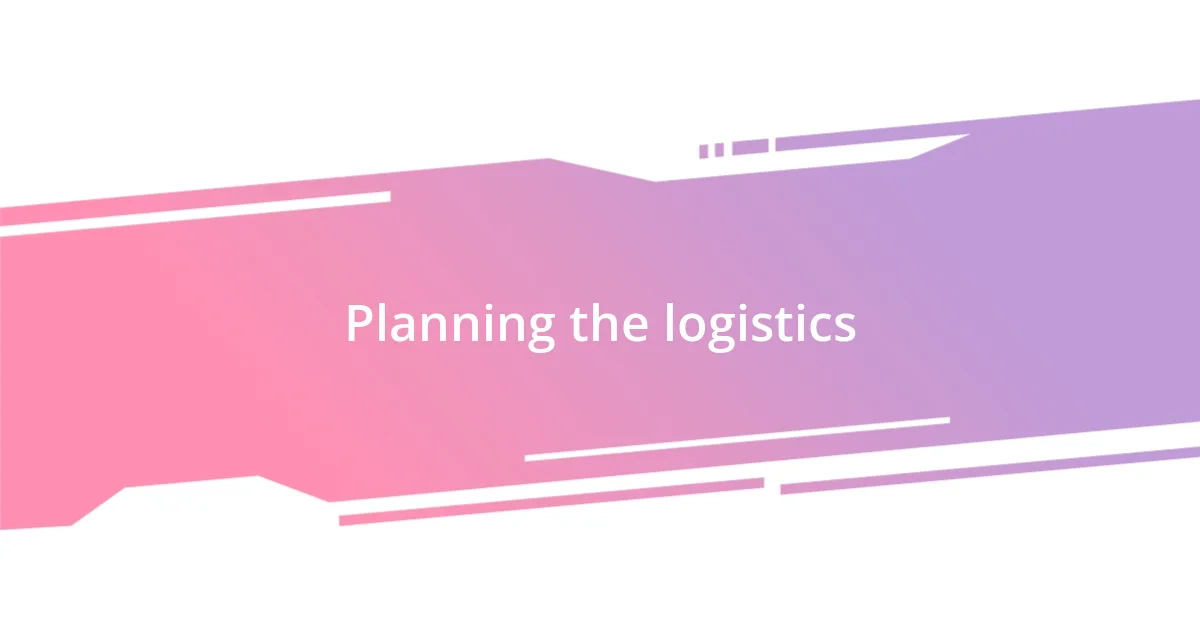
Planning the logistics
When planning the logistics of a scavenger hunt, I always start by mapping out the route. I’ve found that using a simple digital map can help me visualize how each clue flows into the next. For instance, during one scavenger hunt, I used landmarks that created a natural path through the park. This not only improved the participants’ experience by minimizing backtracking but also made the hunt feel like a well-orchestrated journey. Have you ever considered how a thoughtfully planned route can transform the flow of an event?
I also pay close attention to time management, ensuring each clue is designed to take a reasonable amount of time to solve. In my experience, allocating about 10-15 minutes per clue helps maintain energy and enthusiasm. During one memorable hunt, we had a clue that required a bit of teamwork. While some were solving the riddle, others were busy completing a quick task nearby, which kept everyone engaged without feeling rushed. Isn’t it fascinating how teamwork can elevate the experience?
Finally, I can’t stress enough the importance of a backup plan. On one occasion, a sudden rainstorm hit right as the hunt began. Thankfully, I had an indoor location ready to pivot to, turning what could have been a disappointing experience into a cozy adventure in a local café. This taught me that flexibility and preparation are key. How do you handle unexpected challenges in your experiences? I find that a little foresight can lead to incredible moments regardless of the situation!
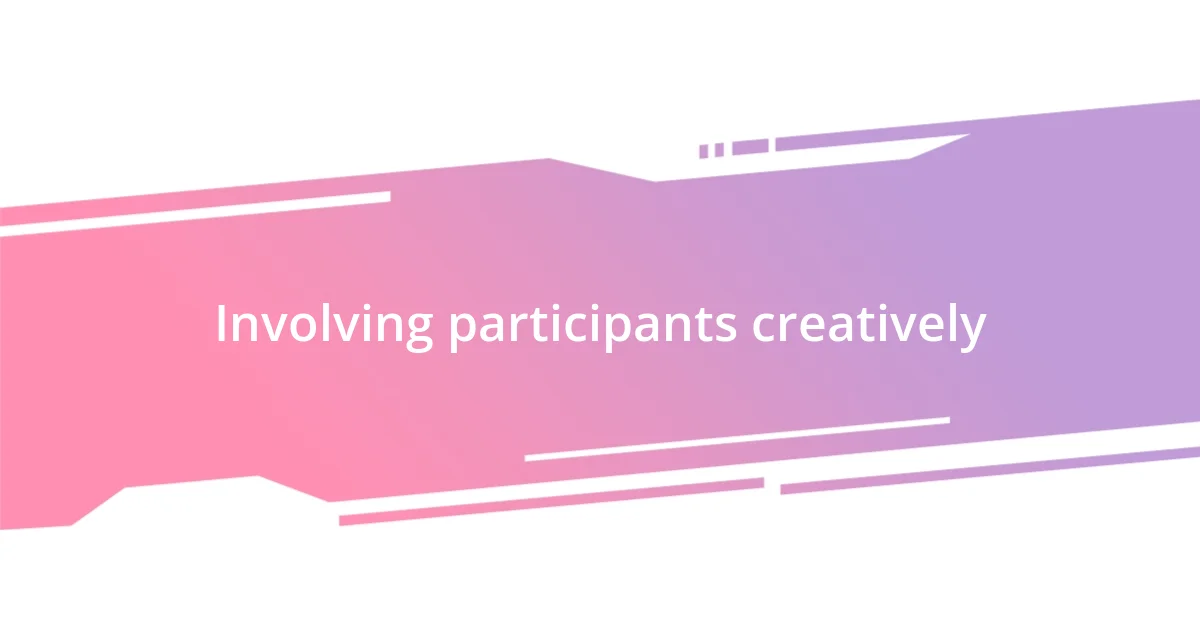
Involving participants creatively
Involving participants creatively can turn an ordinary scavenger hunt into an extraordinary experience. For example, during one event, I encouraged participants to dress as their favorite characters. Not only did this add a playful element, but it also sparked conversations that deepened connections among the group. When everyone embraces their creativity together, it brings a vibrant energy that’s hard to replicate. Have you noticed how a shared theme can unite people in unexpected ways?
Another technique that has worked wonders for me is integrating creative tasks into the clues. I once crafted clues that required participants to create a short skit or a bit of poetry based on the location or item they found. It was amazing to watch laughter and camaraderie blossom as teams collaborated creatively. Seeing the unique interpretations in those moments was a reminder of how diverse our thoughts can be. Isn’t it incredible how creativity can pave the way for such genuine interactions?
I also love to encourage improvisation in scavenger hunts. During one memorable hunt, I randomly announced a “wild card” moment, where participants had to incorporate a spontaneous challenge—like a silly dance at a designated spot. The excitement and laughter that followed reminded everyone that it’s not just about finding items but also enjoying the process. It’s crucial to create environments where spontaneity thrives. How have you seen surprise elements influence group dynamics? I believe they unleash a joy that brings participants closer together.
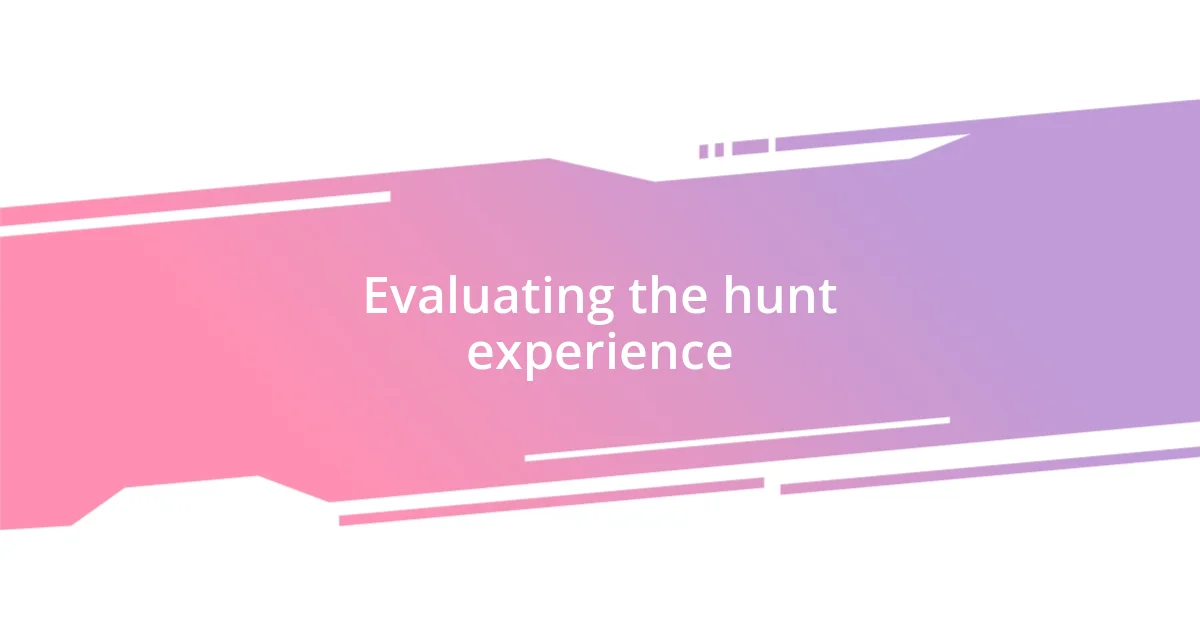
Evaluating the hunt experience
Evaluating the hunt experience is an essential step to ensure that everything comes together harmoniously. I’ve learned that gathering feedback from participants immediately after the event can provide valuable insights. For instance, after one hunt, I discovered that several participants felt a particular clue was overly complicated, leading to frustration rather than fun. Isn’t it interesting how what seems clear to us as planners can feel perplexing to others?
Reflecting on my experiences, I find that observing participants during the hunt can be just as enlightening as post-event surveys. I once noticed a team utterly absorbed in deciphering a clue, their laughter echoing around them. That moment made me realize the importance of balancing challenge with enjoyment. It’s incredible how a simple shift in difficulty can either energize the group or cause them to disengage. Have you ever watched a group’s dynamic shift based on a single clue?
Ultimately, I believe that evaluating the hunt experience isn’t just about what went right or wrong; it’s about understanding the emotions that swirled through the day. After a scavenger hunt I designed, a few participants shared how it allowed them to bond over shared challenges and triumphs. Recognizing those emotional connections reinforces the idea that the experience transcends the hunt itself. Isn’t it rewarding to see how our efforts can cultivate meaningful interactions?












